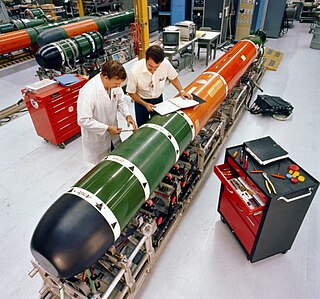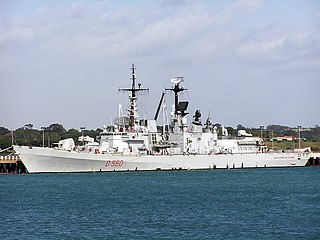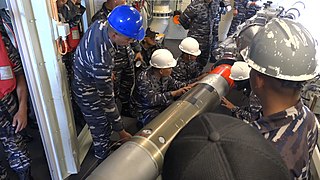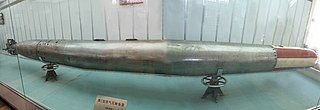
The RUR-5 ASROC is an all-weather, all sea-conditions anti-submarine missile system. Developed by the United States Navy in the 1950s, it was deployed in the 1960s, updated in the 1990s, and eventually installed on over 200 USN surface ships, specifically cruisers, destroyers, and frigates. The ASROC has been deployed on scores of warships of many other navies, including Canada, Germany, Italy, Japan, the Republic of China, Greece, Pakistan and others.

The Santa María class of guided missile frigates is the Spanish Navy's designation for six warships based on the United States Oliver Hazard Perry-class frigates. Spanish ships have a slightly bigger beam and were built with a greater weight reserve for future improvements. Other changes from the basic model include Meroka replacing Phalanx and a RAN-12L air search radar to provide low horizon coverage against sea skimmers cueing the Meroka CIWS mount. The Nettunel EW suite replaced the SLQ-32 system fitted aboard US ships. The first ship Santa Maria entered service in 1986.

The Mark 48 and its improved Advanced Capability (ADCAP) variant are American heavyweight submarine-launched torpedoes. They were designed to sink deep-diving nuclear-powered submarines and high-performance surface ships.

The Mark 46 torpedo is the backbone of the United States Navy's lightweight anti-submarine warfare torpedo inventory and is the NATO standard. These aerial torpedoes are designed to attack high-performance submarines. In 1989, an improvement program for the Mod 5 to the Mod 5A and Mod 5A(S) increased its shallow-water performance. The Mark 46 was initially developed as Research Torpedo Concept I, one of several weapons recommended for implementation by Project Nobska, a 1956 summer study on submarine warfare.

The Mark 54 Lightweight Torpedo is a standard 12.75-inch (324 mm) anti-submarine warfare (ASW) torpedo used by the United States Navy.

The Sting Ray is a British acoustic homing lightweight torpedo (LWT) manufactured by GEC-Marconi, who were later bought out by BAE Systems. It entered service in 1983.

The Mark 44 torpedo is a now-obsolete air-launched and ship-launched lightweight torpedo manufactured in the United States, and under licence in Canada, France, Italy, Japan and the United Kingdom, with 10,500 being produced for U.S. service. It was superseded by the Mark 46 torpedo, beginning in the late 1960s. The Royal Australian Navy, however, continued to use it alongside its successor for a number of years, because the Mark 44 was thought to have superior performance in certain shallow-water conditions.

The Mark 37 torpedo is a torpedo with electrical propulsion, developed for the US Navy after World War II. It entered service with the US Navy in the early 1950s, with over 3,300 produced. It was phased out of service key with the US Navy during the 1970s, and the stockpiles were sold to foreign navies.
The People's Liberation Army Navy (PLAN) is the naval branch of the People's Liberation Army (PLA), the armed forces of the People's Republic of China. The PLAN force consists of approximately 250,000 men and over a hundred major combat vessels, organized into three fleets: the North Sea Fleet, the East Sea Fleet, and the South Sea Fleet.

The Audace-class destroyers were two guided missile destroyers built for the Italian Navy during the Cold War. An improvement of the Impavido class, these ships were designed for area air defence and also had a heavy gun armament. They were fitted with contemporary American radars and sonars, but also, as the next Italian ships, all the modern weapons made by Italian industry of the time, such torpedoes, helicopters and guns. Also some indigenous radars were fitted.

The Durand de la Penne class are two guided-missile destroyers operated by the Italian Navy. The design is an enlarged version of the Audace class, updated with diesel and gas turbine CODOG machinery and modern sensors. Four ships were planned but the second pair were cancelled when Italy joined the Horizon project.
The CY-1 is a Chinese anti-submarine rocket carried on a variety of surface platforms, including the Luda class missile destroyers and Jiangwei class missile frigates. A series of CY ASW missiles have been developed based on CY-1. To date only a small number of CY-1 is known to have been produced and deployed on trial basis, despite the fact that it had first appeared on the defense exhibitions held in China in the late 1980s.

The A244-s is an Italian lightweight, fire-and-forget torpedo employed for anti-submarine warfare. It can be launched from surface vessels or from aircraft, and locates the target by means of an acoustic seeker.

The Yu-1 (鱼-1) torpedo was the first Chinese-built steam-powered torpedo; it was a development of the unguided straight-running Soviet ASuW Type 53 torpedo. It was type classified in September 1971. The Yu-1 was actually the second domestically produced torpedo to enter Chinese service; the first was the Yu-2 torpedo. During the 1980s a version was developed with passive acoustic homing designated the Yu-1A.

Yu-2 torpedo was a Chinese development of the unguided straight-running Soviet ASuW RAT-52 torpedo with passive acoustic homing capability added. The historical background of Yu–2 is identical to that of Yu-1 torpedo and Yu-4 torpedo. Contrary to the higher number assigned, Yu-2 torpedo was the first Chinese domestically produced torpedo entering service, ahead of the Yu-1 torpedo.
The Yu-3 (鱼-3) is a Chinese acoustic homing torpedo designed to be fired from submarines against surface targets. It entered service with the Chinese Navy in 1984. Several sources state that it may be a copy of the Soviet SET-65E, although this seems unlikely as development began in 1965 after the Sino-Soviet split. It is therefore probably the first indigenously developed torpedo in China.
Yu-4 (鱼-4) torpedo is the Chinese development of the Russian SAET-50 ASuW passive acoustic homing torpedo, and it is the Russian SAET-50 torpedo incorporating active acoustic homing guidance. Yu-4 torpedo is often erroneously claimed by many sources as the Chinese version of the SAET-60 acoustic homing torpedo, but Soviets had not completed the development of SAET-60 and only fielded the weapon in 1961, by then the relationship between former-Soviet Union and China had already worsened and China had not received any technical assistance on SAET-60 torpedo. The background of the development of Yu-4 torpedo is identical to that of Yu-1 torpedo and Yu-2 torpedo.
Yu-5 (鱼-5) torpedo is the first wire-guided torpedo developed by China. It is an ASW torpedo designed for conventional diesel-electric submarines. It is often erroneously referred as the Chinese copy of Soviet TEST-71 torpedo, which is incorrect as the Soviet torpedo was developed in 1971 and its successor TEST-71MKE was developed in 1977, at the worst time of Sino-Soviet split. With Yu-5 entering Chinese service in 1989, it was simply impossible to acquire any technologies of Soviet TEST-71 torpedo, which was not purchased by China until 1993, four years after the Yu-5 torpedo had already entered service. The Yu-5 is not a product of indigenous development and is based largely upon previous Soviet and American designs, with much of the propulsion system being derived from the American Mark 46 lightweight torpedo.
Yu-6 (鱼-6) torpedo is the Chinese counterpart of the US Mark 48 torpedo, and it is the first domestic Chinese torpedo designed to counter both surface ships and submarines from the very start. Guidance can be by wire, active and passive homing, or wake homing. Domestic Chinese sources have claimed that the Yu-6 torpedo is in the same class as the Mk 48 Mod. 4 torpedo, and it is believed to have been cloned from a captured sample, but official information on the Yu-6 torpedo is limited.
The Yu-7 is a lightweight torpedo developed by the People's Republic of China. It entered service in the 1990s as the principal anti-submarine weapon of major People's Liberation Army Navy (PLAN) warships. The Yu-7 is a derivative of the Whitehead Alenia Sistemi Subacquei (WASS) A244/S torpedo.













